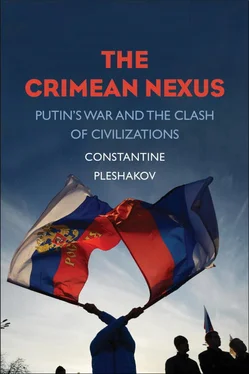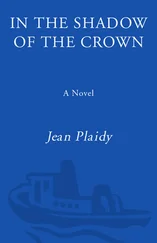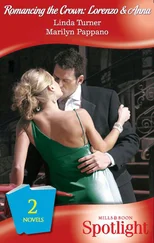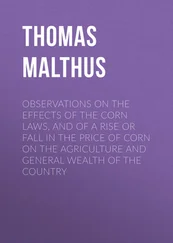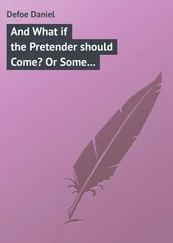After Putin decided to have boots on the ground, military professionals arrived, bringing advanced weapons such as Buk surface-to-air missiles. It is unlikely that the Russian high command planned attacks or calculated strategic costs in Donbass. Most probably, it just made sure that the separatists had everything necessary to sustain their armies. The Kremlin stayed in the shadows, allowing the leaders of the two “people’s republics” every foolishness. The purpose was to keep the rebellion aflame.
At the end of 2014, New York Times correspondent Andrew Roth wrote: “The scale of destruction throughout the region is often breathtaking. Residential apartments bear craters from tank shells. Many places, especially smaller towns, lack basic utilities, like water and electricity. Power lines have been downed, mines flooded, substations incinerated and rail service halted.” The “minister” of building, architecture, and utilities of the Luhansk “People’s Republic,” plucked straight “from the trenches,” still sported a pistol on his hip. The regime imposed by the insurgents was a mixture of village justice, warlordism, and patriarchy. An attempt was made to prohibit single women from visiting bars and clubs. [8] Andrew Roth, “Ukrainians in the Battered East Scramble in Darkness as Winter Nears,” New York Times , November 1, 2014.
With Donbass, the Kremlin miscalculated. The annexation of Crimea had brought it only a slap on the wrist: Crimea was a disputed territory with a complicated past; the takeover had been bloodless. The insurgency in Donbass turned very bloody very early. The almost certainly accidental shooting down of a Malaysian plane in July 2014, by either separatists or the Russian military, epitomized the outrage felt around the world. The separatists obstructed the investigation while Moscow refused to acknowledge its presence in Donbass and blamed the Ukrainian air force. After that, sanctions against Russia began to hit at the very heart of the Russian economy—its energy sector and the banks sustaining it. Later in the year, Putin officially announced that Russia was in recession; he urged his compatriots to tighten their belts. [9] “Eto ne plata za Krym, eto plata za samosokhraneniye,” Gazeta.ua, December 18, 2014, http://gazeta.ua/ru/articles/politics/_eto-ne-plata-za-krym-eto-plata-za-samosohranenie-putin-o-krizise-v-rf/599495 (retrieved December 19, 2014).
He wouldn’t admit the presence of Russian military personnel in Donbass until December 2015. [10] “Vladimir Putin Press Conference,” The Guardian , December 17, 2015.
In the wake of the annexation of Crimea and war in Donbass, Russia experienced an upsurge of jingoism and xenophobia, both spontaneous and Kremlin-propagated. The consequences are bound to be extensive: the unleashed aggression targets not just Ukraine or the West but virtually any group the Russian patriotic majority chooses to see as the Other—including domestic liberal opposition and every minority.
Referring to previous coups in the near abroad—in Georgia and Kirgizstan as well as Ukraine—Putin declared that the world could now see “what tragic consequences the wave of the so-called color revolutions has led to. …We have to do all that is needed to ensure that similar things never happen in Russia.” His foreign minister seconded that: “The West is making clear it does not want to force Russia to change policy but wants to secure regime change.” [11] “Ukraine Crisis,” BBC, November 22, 2014, www.bbc.com/news/world-europe-30158978 (retrieved November 22, 2014).
In December 2014, Russia officially adopted a new military strategy. The list of threats to Russia now included NATO “moving closer” to Russia’s borders; political coups in neighboring countries and the installment of anti-Russian regimes there; and destabilization of Russia to promote “violent regime change.” [12] “Voennaya doktrina Rossiiskoi Federatsii,” Rossiiskaya gazeta , December 30, 2014, www.rg.ru/2014/12/30/doktrina-dok.html (retrieved January 9, 2015).
The last accusation had not been heard from the Kremlin since the Stalin era.
By nurturing the insurgency in Donbass, Putin gambled with Russia’s future in more ways than one. Unleashing the vengeful rabble was perhaps worse than losing standing with the great powers of the West. When, at some point, the Russian street turns its attention to corrupt administrators in Russia, the rioters are likely to use the same methods Russian volunteers used in Donbass: lynching, looting, killing. The tiger has tasted blood, and as Alexander Pushkin put it two centuries ago, God forbid one should ever witness a Russian rebellion, “senseless and merciless.” [13] Kapitanskaya dochka ( The Captain’s Daughter ): Pushkin, Polnoye sobraniye sochinenii , vol. 8, 277–384.
Ukraine as a Failed State
By unleashing war in Donbass, Putin foolishly jeopardized the future of his regime, or “managed democracy” as his ideologues call it. But the other side in the conflict, Ukraine, simply collapsed as a state.
A state fails when it loses (in Max Weber’s famous formulation) its monopoly on the legitimate use of physical force on its territory. The Ukrainian state has done that, and now also meets all the other criteria of a failed state: massive movement of refugees and domestically displaced persons, vengeance-seeking group grievance, the rise of factionalized elites, and the intervention of external actors. [14] “Fragile States Index: The Indicators,” Fund for Peace, http://fsi.fundforpeace.org/indicators (retrieved May 11, 2016).
The movement of refugees and displaced persons is the largest in Europe since World War II; as of August 2015, according to United Nations data, at least 1.3 million people had been “internally displaced” within Ukraine, and 900,000 had fled abroad, mostly to Russia. [15] “Ukraine: UN Warns Number of Displaced Persons and Refugees on the Rise,” U.N. News Centre, June 18, 2015, www.un.org/apps/news/story.asp?NewsID=51193#.VdXfjyxViko (retrieved August 20, 2015).
“External actors”—Russia and NATO—were fighting a proxy war in Donbass. Vengeance-seeking groups enjoyed the support of about 5 percent of Ukrainian voters, but their influence was so disproportionately big that the failure of democracy in Ukraine was hard to dispute. David Stern of the BBC wrote that because no one in Kiev wanted to “provide fuel to the Russian propaganda machine,” the presence of the far right in positions of authority went unmentioned. Meanwhile, according to Stern, commanders of the neo-Nazi Azov Battalion were close to the Ukrainian Ministry of Interior; one of them was named police chief of the Kiev region. After the Maidan uprising, the crime rate throughout Ukraine increased by 40 percent, military and police arsenals had been looted, and more weapons came from eastern Ukraine. In August 2015, members of another right-wing party, Oleh Tyahnybok’s Svoboda, clashed with police in front of the parliament building in Kiev, killing three servicemen. [16] Stern, “Ukraine Underplays Role of Far Right”; “Death Toll Rises to Three from Grenade Attack Near Ukrainian Parliament,” Radio Free Europe/Radio Liberty, September 1, 2015, www.rferl.org/content/ukraine-second-national-guardsman-dies/27220213.html (retrieved September 13, 2015).
Within a year, the power of warlords spread beyond the war zone. In July 2015, a Right Sector battalion clashed with government forces in the town of Mukachevo in western Ukraine. The fighting originated in a business dispute over trade in contraband cigarettes: Mukachevo sat on Ukraine’s border with Hungary. Several people died; the weapons used included machine guns and grenade launchers. [17] David Stern, “Ukraine Clashes Raise Questions over Right Sector Militia,” BBC, July 15, 2015, www.bbc.com/news/world-europe-33523869 (retrieved August 20, 2015).
Читать дальше
